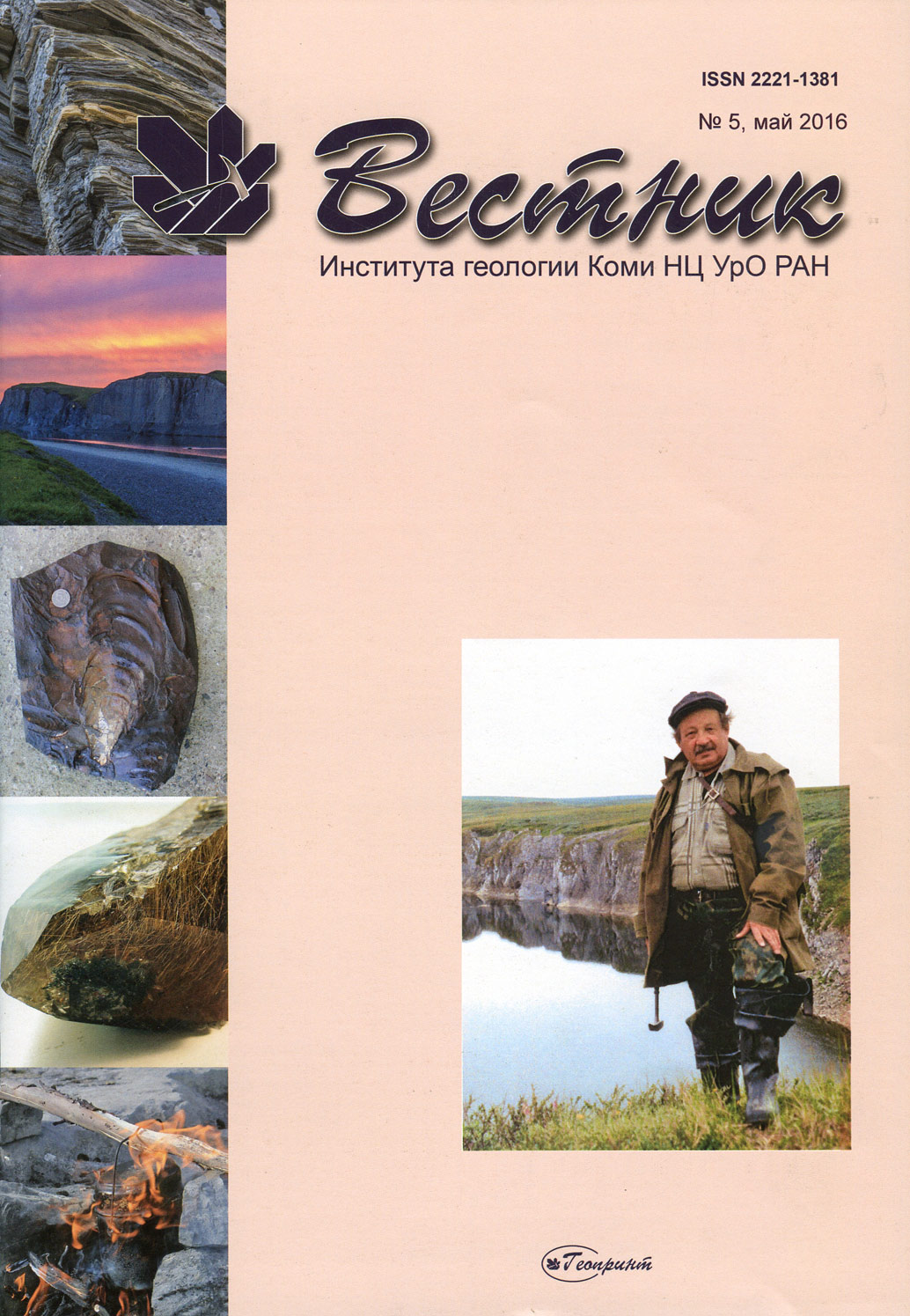| Contents |
2 |
| |
|
|
To the anniversary of N. P. Yushkin
|
|
| Academician N. P. Yushkin's 80th birthday |
4 |
| |
|
|
Remained in memory...
|
5—6 |
| |
|
|
The Third Yushkin Readings
|
7—8 |
| |
|
|
Cavalese and Komi Republic closer to each other
|
9—12 |
| |
|
| Научные статьи / Scientific articles |
|
Micronanoblock crystal growth
A. M. Askhabov
In connection with the anniversary of academician N. P. Yushkin we discussed the development of ideas about the growth of crystals by aggregating crystal particles called micro block growth of crystals by N. P. Yushkin. It is shown that micro and nano block crystal growth does not conflict with modern concepts of crystallization processes. Moreover, in recent years there has been a growing interest in non-classical mechanisms of nucleation and crystal growth.
Keywords: micronanoblocks, crystal growth, quatarons.
DOI: 10.19110/2221-1381-2016-5-13-18
 Download full text Download full text
|
13—18 |
Current research of fossil bone detritus: paleontology, mineralogy, geochemistry
V. I. Silaev, D. V. Ponomarev, S. N. Shanina, I. V. Smoleva,
E. M. Tropnikov, A. F. Khazov
We characterize the principles and methods of mineralogical and geochemical studies of fossil bone detritus in order to obtain a variety of information about the primary biological properties of the organisms and the conditions and results of the fossilization of their skeletal remains. Examples of studying the microstructure of the bone (optical, scanning electron, atomic force probe microscopy), and nano porous (kinetic nitrogen adsorption-desorption), chemical composition (X-ray fluorescence analysis), trace elements (mass spectrometry, inductively coupled plasma), phase composition biomineral components (X-ray diffraction, infrared spectroscopy), elemental (gas chromatography), a molecular group (IR spectroscopy), an amino acid (gas chromatography) of the composition of bone collagen, the isotopic composition of C, O and N (isotope ratio mass spectrometry in conjunction with gas chromatography) are discussed. It is concluded that the development of a conscious and fruitful use of multiple precision complex mineralogical, physical, physica-chemical and chemical methods can ensure a successful future of paleontology.
Keywords: fossil bones, mineralogical and geochemical studies, genetic information.
DOI: 10.19110/2221-1381-2016-5-19-31
 Download full text Download full text
|
19—31 |
Vertex and rib truncations of closed simple forms:
for the 280th anniversary of Zh. B. L. Romeu de Lille
and the 80th anniversary of N. P. Yushkin
Yu. L. Voytekhovsky, D. G. Stepenschikov
|
32—37 |
Geochemistry and U-Pb age of zircon from pizhemskoe titanium deposit (Middle Timan)
A. B. Makeyev, A. O. Krasotkina, S. G. Skublov
The geochemical studies are devoted to the memory of Academician N. P. Yushkin, who during his life paid much attention to this scientific direction. For the first time zircons from the titanium ores of Pizhemskoe deposit were analyzed with local dating (U-Pb method, SHRIMP-II). The wide range of age values within the interval from 2740 Ma to 334 Ma was determined. The ages could be arranged into three groups: neoproterozoic (5 points), meso- paleoproterozoic (26 points), archaean (3 points) with marked polymodal distribution of maximums in the intervals of 600, 900, 1000—1600, 1600—2000 and 2660–2740 Ma. The geochemical type of zircon with xenotime heterovalent isomorphism (Zr+Si)4+ (Y+REE)3+ + P5+ was determined. The relatively low Y + REE content in the range of 150 to 3000 ppm is common for the majority of grains. However the data selecting includes more than 10 % of zircon grains with anomalously high total content of these elements up to 1—3.5 % wt., which also correlates with P content. The obtained material corresponds to the dating results and geochemistry of zircons selected from overlying conglomerate-breccia bed of the Ichetyu occurrence and chetlasskiy lamprophyres. The specific «Timansky» type of yttrium-phosphorus-rare-earth zircon was determined. This fact proves a single zircon source for both industrial sites. In addition zircon could originate from different depth levels of underlying crystal basement. The zircon dating shows that the titaniferous formation is elder than it was considered earlier (Middle Devonian) and its age should be estimated as Precambrian.
Keywords: zircon, Pizhemskoe deposit, U-Pb age, rare earth elements, Middle Timan.
DOI: 10.19110/2221-1381-2016-5-38-52
 Download full text Download full text
|
38—52 |
Study of supermolecular structure of fibrous kerite from Volyn
Ye. A. Golubev, O. V. Martirosyan
We present results of the study of Volyn fibrous kerite by the atomic force and scanning electron microscopy, infrared spectroscopy, thermal analysis. The supermolecular structure of kerite, consisting of nano-sized fibers and globules, is described. The results of IR spectroscopy and thermal analysis show that Volyn kerite previously ranked among the higher oxidized kerite group, chemically corresponds to the lower oxidized kerite. This research is devoted to the memory of Academician N. P. Yushkin who in his last years devoted much attention to this unique natural bitumen. He considered it as one of the fundamental building blocks to create his theory of hydrocarbons crystals as protoorganisms and biological systems predecessors.
Keywords: Volyn kerite, supermolecular structure, atomic force microscopy, infrared spectroscopy, thermal analysis.
DOI: 10.19110/2221-1381-2016-5-53-58
 Download full text Download full text
|
53—58 |
| |
|
| Chronicle, events, facts |
|
| For the 85th anniversary of E. I. Loseva |
59—60 |
| |
|
| For the 80th anniversary of V. G. Olovyanishnikov |
60 |













